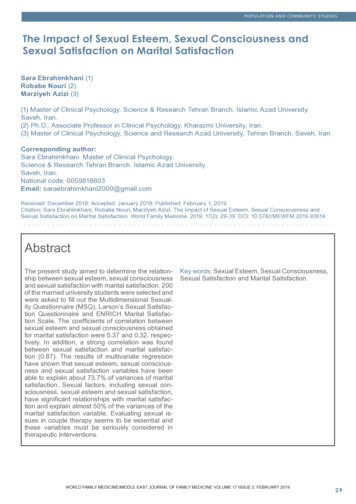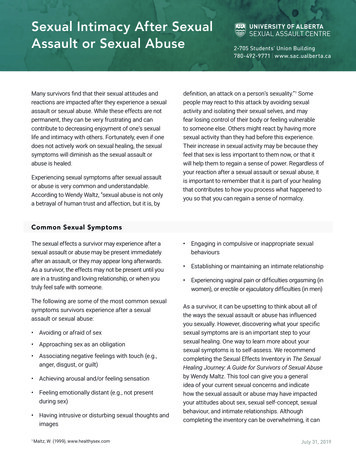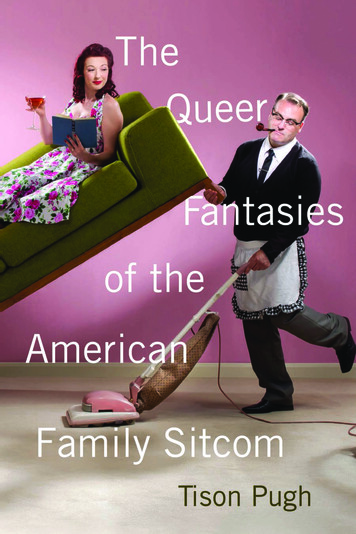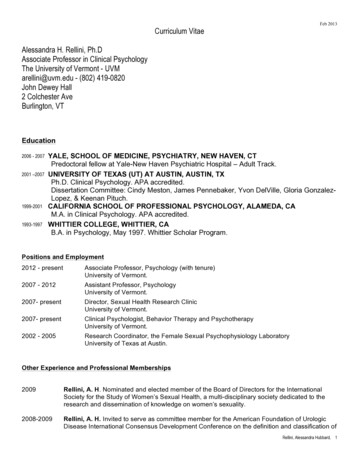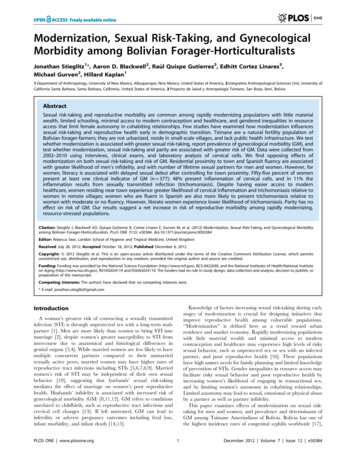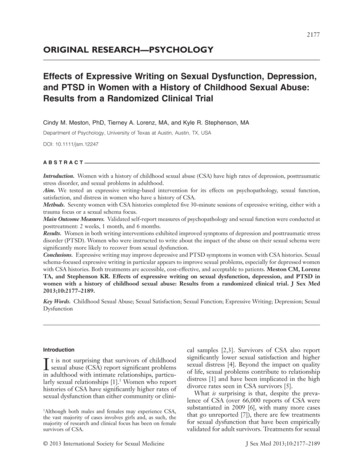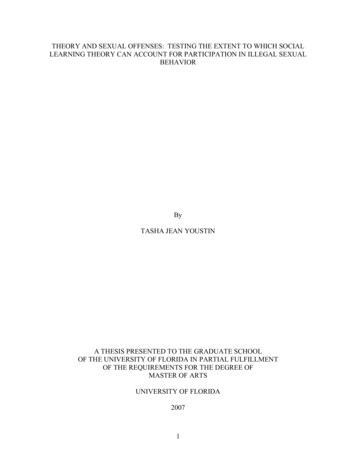
Transcription
SexualOffendingTheory, Research, and PreventionReviewHigh Risk Sexual Fantasies and Sexual Offending: AnOverview of Fundamentals and InterventionsAstrid Rossegger 1,2, Ross M. Bartels 3, Jérôme Endrass 1,2, Bernd Borchard 1,Jay P. Singh 2,4[1] Office of Corrections, Zurich, Switzerland. [2] Department of Psychology, University of Konstanz, Konstanz,Germany. [3] School of Psychology, University of Lincoln, Lincoln, United Kingdom. [4] Publication Academy LLC, GreatFalls, VA, USA.Sexual Offending: Theory, Research, and Prevention, 2021, Vol. 16, Article e5291, https://doi.org/10.5964/sotrap.5291Received: 2020-11-27 Accepted: 2021-04-28 Published (VoR): 2021-06-15Handling Editor: L. Maaike Helmus, Simon Fraser University, Burnaby, BC, CanadaCorresponding Author: Astrid Rossegger, Office of Corrections, Hohlstrasse 552, CH-8090 Zurich, Switzerland. Email: astrid.rossegger@ji.zh.chAbstractAlthough deviant sexual fantasizing has been found to be an etiological factor for sexual offending,not all deviant sexual fantasies increase risk equally. The aim of the present overview is to providereaders with an introduction to key terminology, a primer on central clinical theories, and asummary of the research literature on “high risk” sexual fantasies over the past 50 years. First, theimportant difference between “sexual fantasy” and “sexual fantasizing” is described. Second, thelink between sexual fantasizing and sexual offending is discussed, with a focus on principlemoderators such as physiological reaction, personality profile, and offense-supportive beliefs.Third, the different methods used to assess sexual fantasies are discussed. Fourth, the principlesand techniques behind four evidence-based approaches to treating “high risk” sexual fantasies arediscussed: (1) the behavioral approach, (2) the cognitive approach, (3) the imagination approach,and (4) the mindfulness-based approach. Finally, a call is issued for practice-based quantitative andqualitative research to further explore this clinical phenomenon. The findings of suchinvestigations would advance the field’s understanding of assessment, management, andmonitoring best practices for this important forensic population.Keywordsfantasies, high risk, sexual offending, intervention, treatment, assessmentThis is an open access article distributed under the terms of the Creative CommonsAttribution 4.0 International License, CC BY 4.0, which permits unrestricted use,distribution, and reproduction, provided the original work is properly cited.
High Risk Sexual Fantasies2Highlights There is an important difference between “sexual fantasy” and “sexual fantasizing”,with the former being a knowledge structure in memory that contains informationabout what targets or behaviors an individual finds sexually appealing, whereas thelatter is a cognitive process involving an external or internal cue activating associatedsex-related information stored in one’s memory. Not all deviant sexual fantasies are “high risk”, and not all “high risk” fantasies lead tosexual offenses. The relationship between sexual fantasizing and sexual offending is not direct butrather moderated by three facilitatory factors: (1) physiological reaction, (2)personality profile, and (3) offense-supportive beliefs. Research suggest that practitioners follow one of four approaches to reduce thefrequency and intensity of “high risk” sexual fantasies: (1) the behavioral approach, (2)the cognitive approach, (3) the imagination approach, and (4) the mindfulness-basedapproach.The prevention of sexually motivated violence is a topic of considerable communityinterest internationally, as evidenced by 29 countries throughout North America, SouthAmerica, Europe, Asia, Africa, and Australia having passed legislation mandating regis tration, community notification, and tracking for individuals convicted of sexual offensesat different risk levels (U.S. Department of Justice, 2016). In countries throughout NorthAmerica, Europe, and Australia, such laws also allow for the preventative detention ofindividuals who are judged to be at high risk of sexual recidivism at the end of theirsentence (McSherry, 2014). Although a number of structured assessment and treatmentdecision making tools have been developed to establish management plans for sexualrecidivism risk and to aid in clinical as well as legal decision-making, such protocols donot explicitly include a potentially important and modifiable factor: “high risk” sexualfantasies (Jackson & Hess, 2007). Hence, the aim of the present overview is to providereaders with an introduction to key terminology, a primer on key clinical theories, and asummary of the research literature on such fantasies over the past 50 years.Sexual Fantasy vs. Sexual FantasizingThere is an important difference between “sexual fantasy” and “sexual fantasizing”. Ac cording to Bartels, Beech, and Harkins (2021), a sexual fantasy is a knowledge structurein memory, containing information about what targets or behaviors an individual findssexually appealing (e.g., “My sexual fantasy is having sex with a woman in heeledshoes”). Sexual fantasizing, on the other hand, is a cognitive process. According to theDual-Process Model of Sexual Thinking (DPM-ST; Bartels & Beech, 2016; Bartels etal., 2021), an external cue (e.g., seeing a pair of heeled shoes) or an internal cue (e.g.,Sexual Offending: Theory, Research, and Prevention2021, Vol. 16, Article e5291https://doi.org/10.5964/sotrap.5291
Rossegger, Bartels, Endrass et al.3a memory of a woman in heeled shoes) activates associated sex-related informationstored in one’s memory, giving rise to a spontaneous sexual thought. This thought willbe fleeting unless it grabs the individual’s attention due to eliciting a strong affectiveresponse (e.g., sexual arousal). In this instance, the sexual thought will be automaticallyor deliberately elaborated upon using mental imagery, typically in the form of a movingstory or “script”. And this elaborative process which can reflect a relived experience, aplanned future experience, or a purely wished experience is what is referred to as “sexualfantasizing”. Based on this conceptual distinction, someone may have a sexual fantasythat they never fantasize about and, conversely, may fantasize about a sexual act they donot regard as a fantasy. The importance of distinguishing unintentional fleeting sexualthoughts from active sexual fantasizing will be returned to later in the discussion onassessment.When sexual mental imagery concerns an act that is deemed culturally unacceptable(e.g., pedophilia, voyeurism, frottage, exhibitionism, fetishism, biastophilia, or sadism),it is said to be “deviant”. The use of a deviant sexual fantasy is typically aligned withan existing deviant sexual interest (Noorishad, Levaque, Byers, & Shaughnessy, 2019)and deviant sexual fantasizing has been found to be an etiological factor for sexualoffending (Seto, 2019) as well as a key risk factor for sexual recidivism (Mann, Hanson,& Thornton, 2010). However, not all deviant sexual fantasies are “high risk”, and not all“high risk” fantasies lead to sexual offenses. In fact, sexual fantasies involving deviantbehaviors with adults are common in the general population (Bartels & Gannon, 2011;Joyal, Cossette, & Lapierre, 2015), and the prevalence of child-related sexual fantasiesranges from 1.8% to 13% in men (Dombert et al., 2016; Joyal et al., 2015) and 0.4% to 7%in women (Bartova et al., 2021; Tozdan et al., 2020). The question raised, then, is whatdistinguishes “high risk” sexual fantasies that might lead to actual offenses from thosethat are a part of “normal” human experience?The Link Between Sexual Fantasizing andSexual OffendingResearch indicates that fantasizing about a deviant sexual act is often linked with en gagement in the act itself by both non-offending members of the community (Klein,Schmidt, Turner, & Briken, 2015) as well as individuals previously convicted of a sexualoffense (Turner-Moore & Waterman, 2017). However, recent studies have found thatthis relationship is not straightforward, with fantasy-behavior correlations observed incommunity samples being weaker for deviant content than for non-deviant content(Noorishad et al., 2019). Also, in a sample of only minor-attracted men, sexual fantasizingabout children was not correlated with sexual offending behavior (Bailey, Bernhard, &Hsu, 2016). Such findings suggest that the relationship between sexual fantasizing andsexual offending is not direct but rather moderated by facilitatory factors. A review ofSexual Offending: Theory, Research, and Prevention2021, Vol. 16, Article e5291https://doi.org/10.5964/sotrap.5291
High Risk Sexual Fantasies4the literature suggests three principle moderators: (1) physiological reaction, (2) person ality profile, and (3) offense-supportive beliefs.Physiological ReactionAccording to Smid and Wever’s (2019) Incentive Motivational Model (IMM) of sexualdeviance, a competent stimulus (i.e., a stimulus with incentive value) is one that elicits astrong emotional reaction (i.e., sexual arousal). This reaction signals sexual reward and,thus, gives rise to a feeling of sexual desire; that is, an appeal towards the sexually attrac tive stimulus. Given its incentive value, the stimulus will be sought out for the purposeof sexual gratification (i.e., orgasm), which can include sexual fantasizing. Indeed, sexualfantasizing is often used to induce and increase sexual arousal (Gee, Ward, & Eccleston,2003). Thus, sexual fantasizing can contribute to one’s motivation to sexually offend.And the more one fantasizes about a sexual stimulus, the higher its incentive value willbecome, further increasing the motivation to act.Additional determinants of the strength of a physiological reaction to sexual fantasiesinclude: (1) the imaginal ability of the individual, as men who can form vivid mentalimagery report greater sexual arousal while sexually fantasizing (Smith & Over, 1987);and (2) the emotional valuation of the fantasy content, whereby greater sexual arousalis elicited by positively rather than negatively appraised sexual thoughts (Little & Byers,2000). Hence, if an individual experiences sexual fantasies about rape – for example– as vivid, highly arousing, and positive, then they are at higher risk of engaging insuch behavior. As a corollary, persons convicted of sexual offenses typically fantasizeabout sexual content that matches their offense, with men who have raped a womanfantasizing about rape, men who have sexually abused children fantasizing about childsexual abuse, and so forth (Gee, Devilly, & Ward, 2004).Personality ProfileCertain personality traits have been found to be more common in individuals whosexually fantasize about deviant content. Research on both non-offending members ofthe community (Baughman, Jonason, Veselka, & Vernon, 2014) as well as persons whohave been convicted of a sexual offense (Skovran, Huss, & Scalora, 2010) has establishedpsychopathy as one of these traits. Since low inhibition is a core aspect of psychopathy,it may be that psychopathic tendencies affect the (dis)inhibition of sexual desire andmotivational goals that arise from sexual fantasizing, thus, increasing the risk of sexualoffending. Towards this end, psychopathy has been found to moderate the relationshipbetween sexual fantasizing about deviant content and engaging in such behavior in reallife (Visser et al., 2015). A second personality trait that may play a moderating role isfantasy proneness, defined as a deep and profound involvement in fantasy and imagina tion (Rhue & Lynn, 1987). Individuals scoring high on fantasy proneness measures haveSexual Offending: Theory, Research, and Prevention2021, Vol. 16, Article e5291https://doi.org/10.5964/sotrap.5291
Rossegger, Bartels, Endrass et al.5been found to engage in more frequent sexual fantasizing, including that which involvesdeviant content (Bartels, Harkins, & Beech, 2020). However, further research is needed todetermine the correlation between fantasy proneness and offending behavior.Offense-Supportive BeliefsOffense-supportive beliefs are a key etiological factor for sexual offending (Szumski,Bartels, Beech, & Fisher, 2018) as well as a risk factor for sexual recidivism (Helmus,Hanson, Babchishin, & Mann, 2013). These explicit beliefs are thought to be underpinnedby implicit theories (Ward, 2000): clusters of subconscious core beliefs developed at ayoung age concerning oneself, others, the world, and sexuality. Implicit theories biasthe processing and perception of social information in a manner that increases therisk of sexual offending (Ward, 2000) and can differ depending on the type of offensecommitted. For example, the implicit theories of men who have raped adult womencan lead to the beliefs that women cannot be trusted, that women are sex objects, thatmen have a right to sex with whomever they choose, that dominance is necessary in ahostile world, and that men’s sex drive is uncontrollable (Polaschek & Gannon, 2004). Incontrast, the implicit theories of men who have molested children can lead to the beliefsthat children are sexual beings, that sexual abuse is harmless, that men have the right tohave sex with minors, and that the adult world is hostile (Ward & Keenan, 1999).Implicit theories may also affect the processing of sexual fantasy content such thatoffense-supportive beliefs affect the fantasy-behavior link. In the DPM-ST, it is proposedthat spontaneous sexual thoughts (triggered by a cue) undergo a process of appraisal.This involves validating whether the thought content is congruent with one’s currentbeliefs. If the thought is deemed congruent, it is more likely to be elaborated upon viasexual fantasizing. For example, a man may sexually fantasize about rape if it is congru ent with the belief that women are sexual objects who will enjoy sex even if it is forcedupon them. Indeed, rape-supportive beliefs in community men have been found to becorrelated with sexual fantasies about dominance (Bartels & Gannon, 2009; Zurbriggen &Yost, 2004) and rape (Greendlinger & Byrne, 1987), and hostile beliefs about women havebeen found to be associated with sexually aggressive fantasies (Bartels et al., 2020).It could be that a similar appraisal process occurs in relation to enacting offense-re lated behavior, in that fantasy content that is congruent with one’s offense-supportivebeliefs will be appraised positively and, in turn, be at a greater likelihood to be enacted.In support, sexual aggression in both men and women has been found to be associatedwith sexual fantasies about dominance, but only when the sexual dominance contentis positively appraised (Moyano & Sierra, 2016). Also, men convicted of rape or sexualmurder have reported that the content of their offense-supportive beliefs was reflected inthe content of their sexual fantasies (Beech, Fisher, & Ward, 2005; Beech, Ward, & Fisher,2006) and that enacting these fantasies was the motivation for their offending.Sexual Offending: Theory, Research, and Prevention2021, Vol. 16, Article e5291https://doi.org/10.5964/sotrap.5291
High Risk Sexual Fantasies6Defining “High Risk” Sexual FantasiesThe moderating factors discussed above are key components in the following definitionof “high risk” sexual fantasies proposed by Bartels and Gannon (2011, p. 553): “mentalimagery involving an elaborate sexual scenario or script with distorted aims and/ormeans, whose repeated use can increase the risk of the fantasizer committing a sexualoffense in the presence of certain contexts and/or dispositions” (see Figure 1). Thisdefinition implies that deviant fantasy content may not increase the sexual offense riskof the fantasizer unless they possess traits that facilitate disinhibition or harbor beliefsthat validate the content. Bartels and Gannon (2011) also argue that the content of “highrisk” fantasies need not be deviant, necessarily, but rather can represent a distorted viewof reality. For example, a man may fantasize about meeting an attractive woman in apark, leading her to his car in a display of dominance, and having intercourse with herat his apartment. In this example, there is no culturally deviant content; however, thecontent may be validated by the man’s implicit theories (e.g., women are sex objects andthere is a need to be dominant in a hostile world). This may lead the man to enact hisfantasy script as intended, even if the woman does not consent, ultimately leading to thecommission of a sexual offense.Figure 1Operational Definition of “High Risk” Sexual Fantasies (Bartels & Gannon, 2011)Sexual Offending: Theory, Research, and Prevention2021, Vol. 16, Article e5291https://doi.org/10.5964/sotrap.5291
Rossegger, Bartels, Endrass et al.7Assessing “High Risk” Sexual FantasiesAssessing the content and use of “high risk” sexual fantasies is important for bothresearch and clinical practice. The most common methods documented within the lit erature include interviews, fantasy diaries, questionnaires, and asking clients to writeout a favorite sexual fantasy scenario (Leitenberg & Henning, 1995). The first and lastmethods can provide richer detail about the fantasy content which is useful, since,as Turner-Moore and Waterman (2017) have noted, sexual fantasy content is oftencomprised of a specific target, behavior, and location (e.g., oral sex with an ex-partneron a beach). Such methods can also help uncover other useful information such as thetriggers and functions of sexual fantasies. However, these two important methods havetheir limitations. For example, it is difficult to quantify and standardize the data obtainedvia interviews and narratives of fantasy scenarios, and they also do not provide a clearindication of how often clients fantasize about the content they report.In contrast, fantasy diaries are typically completed over a prespecified time-period,and so can more readily provide frequency data as well as other useful informationregarding content, triggers, and context (McKibben et al., 1994). Researchers and clini cians simply need to ensure that the necessary questions/criteria are incorporated intothe response sheet of the diaries. The challenge, however, is that this method requires re spondents to be aware of and honestly record this information. This can be problematic,as responses may be affected by social desirability biases, and it may be embarrassingor inconvenient to record fantasy information in real-time (e.g., when in the presence ofothers).The final, and most perhaps most common, method for assessing sexual fantasiesis through use of a sexual fantasy questionnaire. These questionnaires are typicallycomprised of a list of sexual behaviors (i.e., items) that a respondent rates on a Likertscale to capture how often they sexually fantasize about each. This enables an array offantasy content to be assessed, including “high risk” sexual fantasies, meaning that usefulinformation about both content and frequency can be obtained. Some notable exam ples of validated questionnaires include the Wilson Sex Fantasy Questionnaire (WSFQ;Wilson, 1978), the Sexual Fantasy Questionnaire (Gray et al., 2003), the Paraphilic SexualFantasy Questionnaire (O’Donohue et al., 1997), and the Multidimensional Assessmentof Sex and Aggression (MASA; Knight et al., 1994). A number of these evidence-basedinstruments are used as part of routine assessment batteries in programs designed totreat sexual offending behavior (see Hudson et al., 2002). However, there are two notablechallenges that researchers and clinicians should be aware of when using sexual fantasyquestionnaires.The first issue with sexual fantasy questionnaires is that the majority of sexualfantasy questionnaires do not provide a clear operational definition of “sexual fantasy”,or they define the term in an all-encompassing manner (e.g., “any sexual thought that isarousing”). This is important to note when we consider the distinction between fleetingSexual Offending: Theory, Research, and Prevention2021, Vol. 16, Article e5291https://doi.org/10.5964/sotrap.5291
High Risk Sexual Fantasies8sexual thoughts and active sexual fantasizing. That is, a client who experiences manyinvoluntary, fleeting sexual thoughts about children will score high on a child-relatedfantasy item. However, someone who frequently and deliberately envisions sexual sce narios involving children for a prolonged period of time would also score high onthis item. Hence, this distinction is important to ascertain, as it can help us to betterunderstand the nature and role of a client’s sexual thoughts. And this is beneficial forcase formulations, management plan development, and monitoring.The second issue with sexual fantasy questionnaires is that they rarely provide anyindication of how the items contained therein may interrelate. A client may activelyfantasize about tying up an older adult, passionately kissing a young adult, and havingsex with a child. These behaviors may be present within a single sexual fantasy scenarioyet, because sexual fantasy questionnaires are comprised of distinct items, these fanta sized behaviors will likely be treated as distinct sexual fantasies. Similarly, differentbehaviors may be fantasized about with different categories of people (e.g., a man with anon-exclusive interest in children may fantasize about romantic behaviors with children,but sexually aggressive behaviors with adult women). The interplay between differentbehaviors and targets cannot be ascertained from most questionnaires at this time, andso would require a follow-up exploration by a skilled researcher or clinician (e.g., via aninterview).Treating “High Risk” Sexual FantasiesGiven its theorized and empirical relationship with sexual offending, sexual fantasizingshould be a target for treatment if the content is deemed to be “high risk” and isfrequently fantasized about. It is not advised that practitioners begin focusing on thereduction of “high risk” fantasies until a therapeutic alliance has been established, asthis is when clients will feel most comfortable in disclosing such personal – in somecases shameful – thoughts. When treatment does begin, it is important at the start forpractitioners to emphasize that it is possible to control “high risk” fantasies, because menwho sexually offend often have the implicit theory that their sexual impulses are uncon trollable (Polaschek & Gannon, 2004). Individuals undergoing sexual offender treatmenthave also rated it as useful to be taught that fantasizing is not wrong in and of itself, thatit is better to accept (rather than to fight) sexual thoughts, and that sexual thoughts aredifferent from actual behavior (Dwyer & Myers, 1990). Finally, it is recommended thata thorough diagnostic assessment be conducted at the beginning of treatment to ensurethat sexual fantasies are not simply intrusive thoughts indicative of a serious mentalillness such as schizophrenia, obsessive compulsive disorder, or post-traumatic stressdisorder. Once these steps have been taken, research suggests that the practitioner canfollow one of four approaches to reduce the frequency and intensity of “high risk” sexualSexual Offending: Theory, Research, and Prevention2021, Vol. 16, Article e5291https://doi.org/10.5964/sotrap.5291
Rossegger, Bartels, Endrass et al.9fantasies: (1) the behavioral approach, (2) the cognitive approach, (3) the imaginationapproach, and (4) the mindfulness-based approach.The Behavioral ApproachThere is mixed evidence as to the usefulness of the behavioral approach in reducing thefrequency and intensity of “high risk” sexual fantasies, particularly in relation to mastur batory reconditioning techniques designed to reduce the level of sexual arousal elicitedby deviant sexual fantasies and/or to increase the level of arousal elicited by non-deviantfantasies. These techniques include thematic shift (Marquis, 1970), fantasy alternation(Abel, Blanchard, Barlow, & Flanagan, 1975), directed masturbation (Maletzky, 1985), andmasturbatory satiation (Marshall & Lippens, 1977). Thematic shift involves the clientmasturbating while imagining acting out their deviant sexual fantasies and then switch ing to a non-deviant sexual fantasy prior to orgasm. Fantasy alternation involves theclient masturbating on multiple occasions in a phallometric laboratory setting, alternat ing between deviant sexual fantasies and non-deviant sexual fantasies until the clientrecognizes they are able to be aroused by non-deviant stimuli.Directed masturbation involves the practitioner instructing the client only to mastur bate to non-deviant fantasies, often using prepared scripts and visual aids, to reinforcethe strength of the client’s arousal to this sort of fantasy, hence increasing its frequency.Masturbatory satiation involves the client masturbating while imagining acting out theirdeviant sexual fantasies and then, after orgasm, continuing to masturbate for an exten ded period of time, resulting in boredom, fatigue, and discomfort.In a review of these techniques, Laws and Marshall (1991) concluded that direc ted masturbation and masturbatory satiation have empirical support for their effica cy, whereas thematic shift and fantasy alternation do not. More recently, Allen andcolleagues (2020) conducted an updated systematic review and found that treatmentprograms that incorporated behavioral reconditioning techniques (especially those thatemployed more than one technique) were effective at reducing the frequency of deviantsexual fantasizing. In addition, Gannon and colleagues (2019) recently published a meta analysis which found that the general inclusion of behavioral reconditioning techniquesin sexual offending treatment programs added incrementally to the programs’ efficacyin reducing sexual recidivism (Gannon, Olver, Mallion, & James, 2019). Hence, furtherresearch is necessary to expand the evidence base to clarify how techniques followingthe behavioral approach can be most helpful to practitioners and their clients.The Cognitive ApproachThe cognitive approach to treatment focuses on disrupting the thought processes under lying “high risk” sexual fantasies. The most commonly employed technique by practi tioners following the cognitive approach is thought suppression, which involves askingSexual Offending: Theory, Research, and Prevention2021, Vol. 16, Article e5291https://doi.org/10.5964/sotrap.5291
High Risk Sexual Fantasies10clients to actively try to stop imagining deviant sexual fantasies. Qualitative researchsuggests that men who have sexually offended also self-report engaging in thought sup pression, as they view their deviant sexual fantasies as having had a causal role in theiroffending, or because the fantasies remind them of the consequences of their offense(Gee et al., 2004). Although thought suppression is commonsensical, the technique hasbeen found to actually increase the frequency of targeted fantasies post-suppression,making it “at best a weak strategy, and at worst dangerous” (Shingler, 2009, p. 51).A lesser used but empirically more promising cognitive technique involves image ry-competing tasks, which are tasks performed at the same time as the targeted mentalimagery. Since both the task and the imagery compete for working memory resources,the experience of the mental imagery becomes impaired. The DPM-ST proposes thatsexual fantasizing requires the resources of working memory as it involves finding,manipulating, and holding in mind the information needed to construct sexual mentalimagery (Bartels et al., 2020). Based on this premise, Bartels et al. (2018) recruiteda non-forensic sample to examine whether the imagery-competing task of bilateraleye-movements (performed while fantasizing sexually) led to an impairment in sexualfantasy content. As hypothesized, taxing working memory via eye-movement led to asignificant reduction in sexual fantasy vividness, emotionality, and arousability, relativeto the “no eye-moment” condition. This signifies a promising treatment technique thatcould be implemented across treatment formats (Allen et al., 2020). However, furtherresearch is needed to test its efficacy in relation to “high risk” sexual fantasies andforensic populations.The Imagination and Mindfulness-Based ApproachesAlthough there is currently a limited evidence base regarding the efficacy of the imag ination and mindfulness-based approaches to reducing the frequency and intensity of“high risk” sexual fantasies, there is theoretical justification for the utility of the methodsfalling under these modalities. In both approaches, the practitioner plays a central role,inducing deviant sexual fantasies and then helping the client to modify their reactionto the mental representation in real time. The intensity of the fantasy content can bechanged depending on the practitioner’s level of descriptiveness, as well as the client’smoving of their eyes horizontally or vertically during the induction process (Marks,1973).The aim of the imagination approach is to reduce the attractiveness of “high risk”sexual fantasies for clients (Urbaniok & Endrass, 2006). This is accomplished by methodssuch as pausing or modifying aspects of the sexual fantasy to dampen the client’sstimulation while fantasizing. For example, practitioners can train clients to add orremove color from fantasies, or to zoom in or out of any particular aspect of their script.By reinforcing these modified fantasies, practitioners may selectively reinforce aspectsof the mental representations to support the development of new, lower risk thoughtSexual Offending: Theory, Research, and Prevention2021, Vol. 16, Article e5291https://doi.org/10.5964/sotrap.5291
Rossegger, Bartels, Endrass et al.11patterns. This approach shares similarities to “imagery rescripting”, which has showngreat promise in other clinical domains such as PTSD, social anxiety disorder, and
cording to Bartels, Beech, and Harkins (2021), a sexual fantasy is a knowledge structure in memory, containing information about what targets or behaviors an individual finds sexually appealing (e.g., "My sexual fantasy is having sex with a woman in heeled shoes"). Sexual fantasizing, on the other hand, is a cognitive process. According to the
